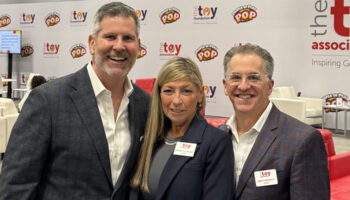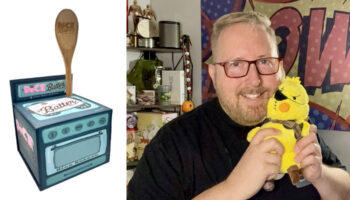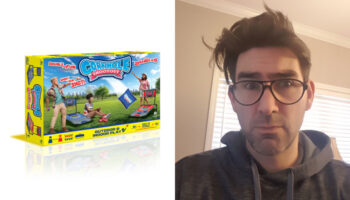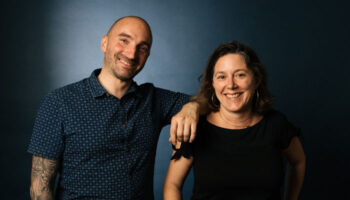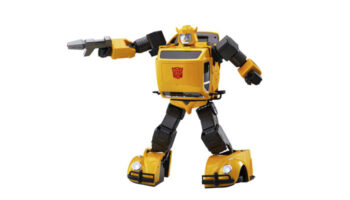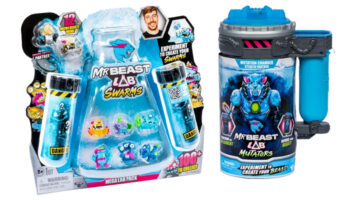Gary Pyper talks creativity, ‘Monkey Tennis’ and what to expect from his new invention house, Fun-Damental
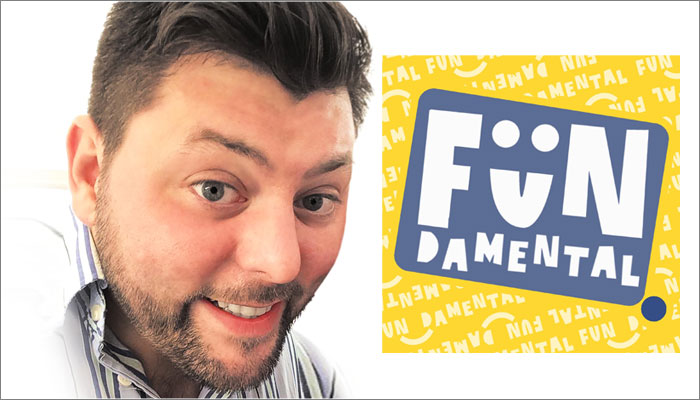
From creating rocket power cars out of deodorant cans as a kid, to bringing a blow-up doll to an ideas meeting at Seven Towns, Gary Pyper has always been an inventor.
He has spent a large chunk of his toy industry career working at Notting Hill-based design studio Seven Towns, first as design director and then as senior VP of design and development, where he oversaw work on hits including Greedy Granny and, the result of said blow-up doll meeting, Who’s the Dude? But after 15 years, Pyper has decided to leave Seven Towns to set up his own brand new invention house, Fun-Damental.
We caught up with Pyper to learn more about his history in the design space, what to expect from Fun-Damental and why Alan Partridge might’ve been onto something with that ‘Monkey Tennis’ idea…
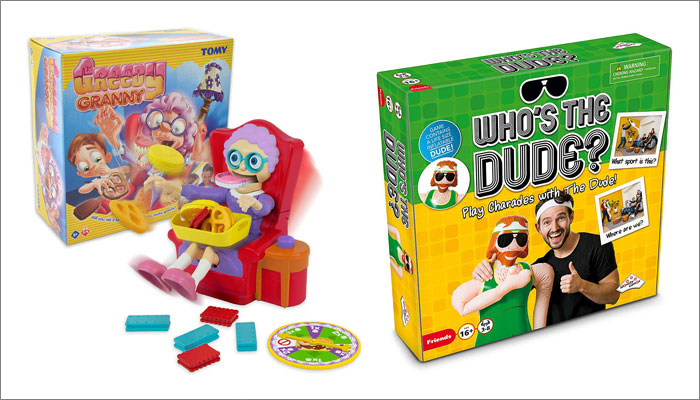
How did you take your first steps into the world of toy and game design?
I’ve always been an inventor. As a kid, I was once confronted by my mum and dad who were concerned that I was sniffing aerosols because I was getting through a lot of deodorant cans. But what I was actually doing was making rocket-powered cars! I also made landmines underneath my carpet to try and scare my mum, and once I actually cut a hole in my bedroom door and screwed on hinges to make it like a prison door – so I was always taking things apart and making things, obsessively really.
I then went to university and did a product design course, graduated and got a job with a giftware company. They were designing lots of lines of seasonal giftware, but the great thing was that there were so many production techniques in play – you’d be doing resins, vinyls, production moulding etc.
One day, there was a problem and they needed someone to go to the Far East. I didn’t have any commitments so I said “I’ll go!” Next thing I know I’m in Shenzhen, in a factory, and I was there for six months. Up to that point, I’d imagined that everything came out of a big shiny product machine – I had no idea that people were there making it. I thought, as lots of consumers do, that craftsmanship is dead and that’s why everything is made in China. But what I realised is that it’s not dead, it’s just that everyone in China is a craftsman. So I saw everything get made and started to understand injection moulding and the processes, and I fell in love with it.
When I was there, we were working on licenced Sindy doll giftware. There was a situation where the rights to the doll line were up for grabs. We thought, why don’t we do it, and we went for it. We started making a full fashion doll range. That’s how I learnt how to build a toy line.
One of the first toy items I created was a Sindy boutique salon play-set, and I remember going to see the commercial shoot for it, and they’d built it life-size. I walked around it, just as I had walked around it in my head when I was designing it, and that was a real rush.
And what was it about seeing that that gave you such a rush?
Well as a kid, I was only good at making stuff. It gave me a sense of achievement, and if you make something, it only exists because of you; it’s a kind of acknowledgement that you exist and an endorsement. It was amazing to see.
That’s why being an inventor and licensing concepts is so appealing. You can just do the fun creative bit, over and over again. With that in mind, you also have to know how to do the other bits too.
And post-Sindy, you spent 15 years with Seven Towns, first as design director before becoming VP of design and development. How did your time there shape you as a designer?
I went to Seven Towns feeling pretty confident. I was young, I’d been in the Far East, I’d done all this stuff, I knew how it all worked, and then at Seven Towns I met some of the most remarkably creative people I’d ever met. In lots of toy firms, you get the engineering specialist and the graphics guy, and the marketing person, but good inventors have to be all of them. When you manage to find someone that can be all those, then they’re special – and they were at Seven Towns.
I was shocked when I first joined. My youthful ego didn’t last long! But I learnt a huge amount quickly.
Thinking back across your time at Seven Towns, which products that you and the team worked on do you look back on with fondness?
During my career to date, I have had a hand in over 100 products going to market so it’s tough to choose one. But it’s the ones that break the mould that you remember. The ones you can’t believe we did, like Who’s the Dude?
I bought a sex doll and wrote Who’s the Dude on it in pen and took it to our ideas meeting. It’s the ones that you think ‘this is too much’, but they then slip through the net! They’re the ones I’m most proud of.

And now, you’ve left Seven Towns to launch Fun-Damental, a brand new invention house. Talk us through it.
It’s a cross-category invention house. I’ll be creating games, toys, craft activities – everything. At the moment, the intention is that it’s a pure new concept IP creation company, not a design for hire studio.
I’m lucky through my experience that I have made lots of good friends in the business. I can’t be everything that Seven Towns is, as there’s only one of me, but over time I hope to become an established and well-respected major invention house.
And would you say there’s something in everything you design that has your stamp? What makes a ‘Gary Pyper’ product?
I think they’ve all got humour. The important thing about any product is that it provokes an emotive response. A lot of my creations are quick to get a reaction. I like to think of my products as magic tricks – they make you go ‘wow’.
I think the best products tap into a human need. Monopoly is about money, Operation is about death – they’re packaged in a comfy way but they’re big, fundamental themes. Look at Greedy Granny. It was created because everyone has got a grandma and it’s funny to (respectfully) laugh at old people! There were some concerns originally about theme, but it’s done very well and in the US it’s been massive. And it was based on my gran! She sits in her chair, and now she’s got a Greedy Granny sitting next to her! She’s very proud.
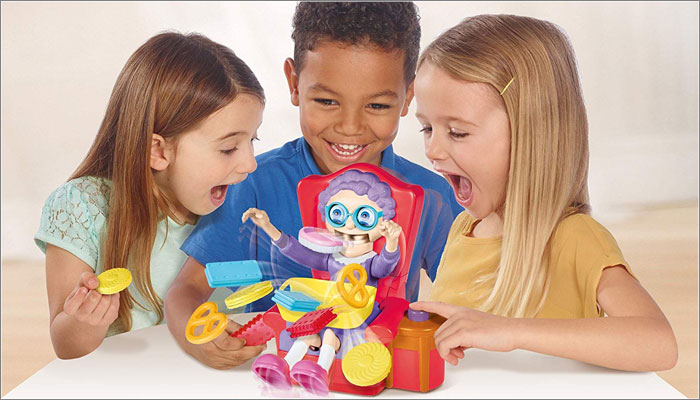
Where do you find your ideas come from?
Good props for toys and games are hiding in plain sight. Look at Who’s the Dude? Girls go out on hen dos and carry those blow-up men around. The fact is that until Who’s the Dude?, it hadn’t been shifted sideways into the game area.
That’s why many inventor submissions are mediocre. You get games that have been designed to be games. Back at Seven Towns we often referred to Alan Partridge with his ‘Monkey Tennis’ idea – two objects that shouldn’t be together, but that’s where some great concepts come from.
Looking at the industry today, are we in a good place creatively?
It’s a very exciting time. In the Sixties and Seventies, if you wanted to be a designer, you went to art college. It was a trade and you could only do it if you’d been trained. Now, there is nothing holding anyone back from making something.
I work with the Design Council as a mentor on their accelerator programmes, and we get a lot of inventors that have had an idea and just gone for it. They have no inhibitions about being wrong or feeling stupid and that’s amazing. The problem with it is overpromising. Making a product look good or saleable or appetising or YouTube-able is different from delivering an on-cost, on-time engineered product.
So it’s brilliant that anyone can make stuff without any inhibitions, but I think there does need to be some formal training as to how you make that thing, and how you make it economic.
You mentioned making products YouTube-able – has that been one of the biggest things to shake-up the world of toy and game design in recent years? The push towards products that could go viral?
Yes, but as a game inventor you can create lots of different types of games. Those mass-market, TV-advertisable, big-hit games are for a certain type of company. You go to another company and they don’t want to touch that because they’re very high-risk.
It started with a couple of companies doing those types of ground breaking products that were a massive hit, and one game – Pie Face – changed the whole industry but you have to be cautious using social media as your muse. Just because people watch something, doesn’t mean it’s good. It just means a lot of people have looked at it.
The main aim should be to design good products for kids and families. But there are so many people you have to circumnavigate first, and so many criteria. Shelf-space is a hotly contested battlefield, and to get something on shelf you have to make it a credible product and ensure it has guaranteed sales.
What do you do to give your ideas the best chance of being licensed?
Companies reflect the people that run them and work for them. They have the same personality. If you get to know the people, you get a feel for what the company wants. I know what certain companies will think is cool and funny because I know them really well. But as companies change, their wants change, so you have to be intimately close – not in a creepy way, but in a friendly way!
There’s good and bad ideas, but good ideas can be better for some companies than others. I’ve been in meetings where someone has said “that’s no good – I don’t like it at all”, and then in the next meeting I’ve sold it. As long as you have a good product, it will find a home if you meet enough people.
It’s a bit like being a gambler and working out percentages. You might have the best idea but only one person to sell it to, or an okay idea and lots of people to sell it to. You have to work out how to split your time.
Some of the best things I’ve ever done, initially no-one wanted. Some of the big hits at Seven Towns relied on good product, but more importantly good timing. It only takes one person to do something different and for it to be a success and then everyone steers towards it.
Can you talk us through your creative process when it comes to ideation?
Well, coming up with new ideas isn’t always fun! If I met one of the world’s leading brain surgeons I wouldn’t go up to them and say “I’ve had a fantastic idea for a new way to poke around in someone’s head”, but making toys and games and writing kids books seems to be the two things that everyone presumes they can do!
It’s not easy. It’s like if you were a gold miner, you wouldn’t expect to find the best stuff just lying on the surface. You’ve got to dig really deep in places no-one else is looking, and sometimes it makes me feel quite ill! I question myself continually!
I also think it’s key not to be interrupted. Ideas are like little flames on a candle. Interruptions blow the flame out. The best place for me to come up with ideas was on the bus. I was never going to meet anyone I knew, no-one would be staring at me, I was anonymous and the ideas would come. Even now with Fun-Damental, my studio is away from the house and 95% interruption free.
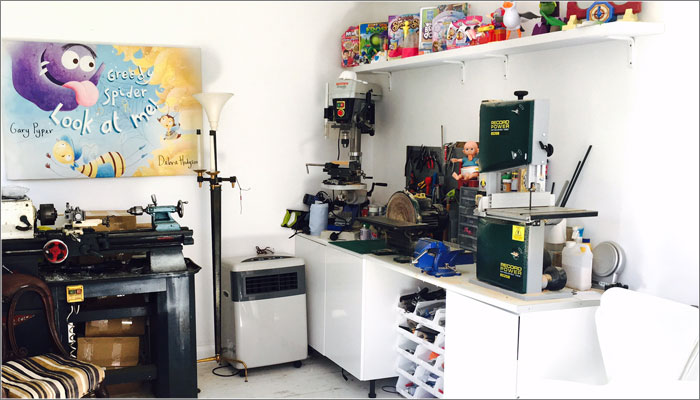
You have to also be very, very self-critical. You need a little man on your shoulder saying ‘you’re shit at this!’ If you haven’t got that, you’ll always believe every idea is the best idea ever. It needs to get past the demon on your shoulder.
While the process of coming up with ideas is very laboured, when one sticks, it can snowball very quickly. If I look back over my notes, any concept where I’ve scribbled ‘good’ next to it the second I had the idea, they all sold. But I never start making something the minute I think of it. To progress an idea in your head or physically, you need adrenaline. When you have adrenaline, you become irrational, so you can quite quickly believe in something that’s bonkers.
The more you labour over an idea, you more precious you get over it. And there’s no shortage of ideas out there, so I don’t go back over old ideas. I just try and think of something else. You eventually sometimes cover the same ground again and that’s hard too because then you discount things because you thought of it 15 years ago, but no one has ever seen it!
What’s the biggest mistake new or amateur designers make when looking to establish themselves in this industry?
It’s the ‘one idea’ problem. There’s a trend of people having an idea and starting a company around that one product. I think it’s because lots of inventors and entrepreneurs don’t understand licensing or even know you can go and license a product. This means they’re stuck filling their garage with product and starting a business.
It’s really important to teach new designers about licensing as an option to market, because that then frees them up to keep creating and not get precious about one idea.





